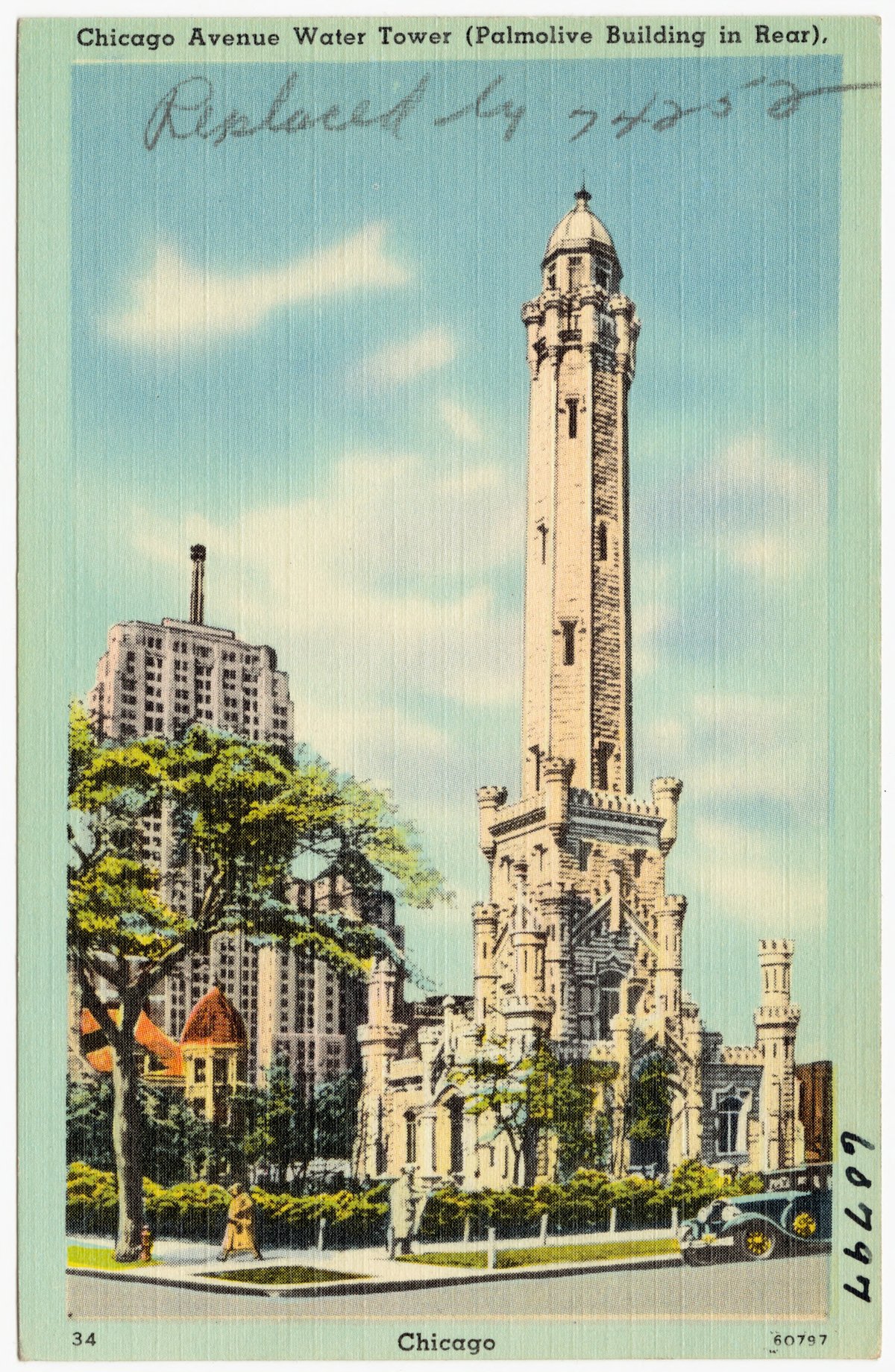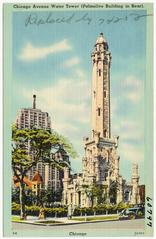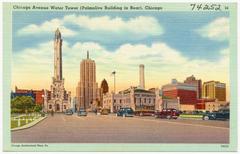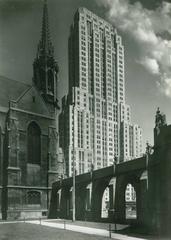
Palmolive Building Chicago: Visiting Hours, Tickets, and Historical Significance
Date: 14/06/2025
Introduction
The Palmolive Building, located at 919 North Michigan Avenue on Chicago’s Magnificent Mile, is a celebrated example of Art Deco architecture and a significant piece of the city’s history. Constructed in 1929 as the headquarters for the Colgate-Palmolive-Peet Company, the building played a pivotal role in shifting Chicago’s business district northward and remains one of the city’s most recognizable landmarks (BuildingsDB; Chicagology). Today, while the building houses luxury residences and offices, its exterior grandeur and occasional public access continue to draw architecture enthusiasts, historians, and tourists alike (Choose Chicago).
This guide offers a comprehensive overview of the Palmolive Building’s historical significance, architectural highlights, visiting hours, accessibility, nearby attractions, and insider tips to help you make the most of your visit.
Table of Contents
- Historical Overview
- Visiting the Palmolive Building
- Nearby Attractions & Travel Tips
- Frequently Asked Questions (FAQ)
- Summary & Recommendations
- References
Historical Overview
Origins and Early Development (1927–1929)
Conceived amidst Chicago’s rapid urban expansion, the Palmolive Building was designed by Holabird & Root and completed in 1929. Its construction on the then-developing northern stretch of Michigan Avenue marked a major shift in the city’s commercial geography (Chicagology; Archiseek). The Colgate-Palmolive-Peet Company sought a prestigious new headquarters outside the crowded Loop, establishing a precedent that helped transform Michigan Avenue into the Magnificent Mile.
Architectural Significance and Art Deco Design
The Palmolive Building is celebrated as a quintessential Art Deco skyscraper. Its six setbacks create a stepped silhouette, both functional—allowing light and air to reach the streets—and visually striking (Choose Chicago). The façade features Indiana Bedford limestone and ornate terra cotta details, while the building’s steel and aluminum mast once supported the iconic Lindbergh Beacon. Upon completion, the 37-story tower was among Chicago’s tallest, its profile a hallmark of 1920s architectural ambition (Archiseek; BuildingsDB).
The Lindbergh Beacon
Installed atop the mast in 1930, the Lindbergh Beacon served as a powerful navigational aid for pilots, shining up to 225 miles and symbolizing Chicago’s embrace of modern technology (Archiseek). The beacon was named for aviator Charles Lindbergh and was a prominent nighttime feature until it was deactivated in 1981 due to concerns from nearby residents. It has since been reactivated for special occasions (Chicagology).
Playboy Era (1965–1989)
In 1965, Playboy Enterprises acquired the Palmolive Building, renaming it the Playboy Building and moving its editorial and business offices to the site (Wikipedia). Illuminated “PLAYBOY” signs and the nickname “The Bunny Building” became part of the local vernacular (Archiseek; Chicagology). Playboy sold the leasehold in 1980 but remained as a tenant until 1989.
Adaptive Reuse and Landmark Status
After a period as 919 North Michigan Avenue, the building’s original name was restored. In 2001, Draper and Kramer converted the office tower into luxury condominiums, preserving its Art Deco details (Choose Chicago; Wikipedia). The building was designated a Chicago Landmark in 2000 and added to the National Register of Historic Places in 2003 (BuildingsDB).
Notable Residents and Modern Prestige
Today, the Palmolive Building is synonymous with luxury, with amenities such as a fitness center, concierge service, and a rooftop deck (Highrises Chicago). Notable residents have included actor Vince Vaughn, who owned a lavish penthouse with panoramic city views (ABC7 Chicago). Its location near Oak Street Beach, Washington Square Park, and the Newberry Library further enhances its allure.
Visiting the Palmolive Building
Visiting Hours & Tickets
- Lobby/Public Areas: Open Monday–Friday, 9:00 AM–6:00 PM.
- Admission: There is no fee for viewing the exterior or visiting the lobby/retail areas during business hours.
- Guided Tours: Not routinely available; check for Open House Chicago or other special events for limited access (chrchicago.com; Open House Chicago).
- Residential & Upper Floors: Not open to the public.
Accessibility
- Physical Access: The lobby and retail spaces are accessible, with ramps and elevators for visitors with disabilities.
- Transit: CTA Red Line (Chicago or Grand stations) and several bus routes nearby; parking garages within walking distance (GPSmyCity).
Events & Photography
- Events: Occasional participation in Open House Chicago and city festivals may grant interior access.
- Photography: Exterior photography is encouraged; interior photography is restricted. The building is especially photogenic at golden hour and after dark when illuminated.
Nearby Attractions & Travel Tips
- Magnificent Mile: One block away, featuring shopping, dining, and entertainment (Choose Chicago).
- John Hancock Center (360 CHICAGO): 0.2 miles, 5-minute walk.
- Museum of Contemporary Art: 0.4 miles, 8-minute walk.
- Oak Street Beach: 0.3 miles, 6-minute walk.
- Tribune Tower: 0.5 miles, 10-minute walk.
- Millennium Park: 1.2 miles, 20-minute walk.
Travel Tips:
- Use public transit or rideshare to avoid high parking fees.
- Dress in layers for variable Chicago weather.
- Visit during festivals like the Magnificent Mile Lights Festival or Open House Chicago for special access and vibrant atmosphere (The Savvy Globetrotter).
Frequently Asked Questions (FAQ)
What are the Palmolive Building’s visiting hours?
Lobby and retail areas are open Monday–Friday, 9:00 AM–6:00 PM. There are no official public hours for interior tours.
Is there an admission fee?
No. Viewing the exterior and lobby/retail spaces is free.
Are guided tours available?
Only during special events such as Open House Chicago; advance reservations required.
Is the building accessible for visitors with disabilities?
Yes, public areas are accessible.
Can I take photographs?
Exterior photography is welcome; be respectful of residents and posted policies.
Are tickets required?
No tickets are needed for general visits. Special tours may require advance booking and a nominal fee.
Summary & Recommendations
The Palmolive Building is a landmark of Chicago’s architectural and cultural history, offering visitors a glimpse of Art Deco elegance and urban innovation. While interior access is largely reserved for residents and tenants, the building’s exterior, lobby, and occasional special events provide ample opportunity to appreciate its design and legacy (BuildingsDB; Wikipedia). Its central location makes it an excellent starting point for exploring the Magnificent Mile and nearby attractions.
Recommendations for Visitors:
- Plan your visit during business hours for lobby access.
- Explore self-guided walking tours via apps like GPSmyCity (GPSmyCity).
- Attend Open House Chicago or other special events for rare interior tours.
- Pair your visit with stops at Oak Street Beach, the John Hancock Center, and the Museum of Contemporary Art.
- Download the Audiala app for curated itineraries, real-time updates, and exclusive guides to Chicago’s historical sites.
References and Further Reading
- Palmolive Building Chicago: Visiting Hours, Tickets, History & Attractions (BuildingsDB)
- Chicago Historical Architecture and Urban Development (Chicagology)
- Palmolive Building Architectural Analysis (Archiseek)
- Palmolive Building Overview (Choose Chicago)
- Palmolive Building Wikipedia Entry (Wikipedia)
- Palmolive Building Visitor Information (Chicago Landmarks)
- Palmolive Building Architecture and Visitor Guide (chrchicago.com)
- Palmolive Building Location and Attractions (Mike Larson Real Estate)
- Palmolive Building Accessibility and Tours (200smichigan.com)
- Palmolive Building Guided Tours and Visitor Tips (GPSmyCity)

































































































































































